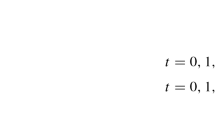Abstract
This paper examines the growth paths that maximize the utility of the worst off generation for an economy where preferences are stationary and can be represented by a recursive utility function. The analysis focuses on the case where second period utility is an inferior good. It is shown that in such a case the maximin growth paths are time inconsistent. A possible solution to the time inconsistency problem is examined.
Similar content being viewed by others
References
Arrow, K. J. (1973): “Rawls' Principle of Just Saving”.Swedish Journal of Economics 75: 323–335.
Asheim, G. B. (1988): “Rawlsian Intergenerational Justice as a Markov-Perfect Equilibrium in a Resource Technology”.Review of Economic Studies 55: 469–483.
Beals, R., and Koopmans, T. C. (1969): “Maximizing Stationary Utility in a Constant Technology”.SIAM Journal of Applied Mathematics 17: 1001–1015.
Benveniste, L. M., and Scheinkman, J. A. (1979): “On the Differentiability of the Value Function in Dynamic Models of Economics”.Econometrica 47: 727–732.
Calvo, G. (1978): “Some Notes on Time Inconsistency and Rawls' Maximin Criterion”.Review of Economic Studies 45: 97–102.
Dasgupta, P. (1974): “On Some Alternative Criteria for Justice between Generations”.Journal of Public Economics 3: 405–423.
Kannai, Y. (1974): “Approximation of Convex Preferences”.Journal of Mathematical Economics 1: 101–106.
Koopmans, T. C. (1960): “Stationary Utility and Impatience”.Econometrica 28: 287–309.
Koopmans, T. C.; Diamond, P. A.; and Williamson, R. E. (1964): “Stationary Utility and Time Perspective”.Econometrica 32: 82–100.
Leininger, W. (1985): “Rawls' Maximin Criterion and Time Consistency; Further Results”.Review of Economic Studies 52: 505–513.
Lucas, R., and Stokey, N. (1984): “Optimal Growth with Many Consumers”.Journal of Economic Theory 32: 139–179.
Stolper, W. F., and Samuelson, P. A. (1941): “Protection and Real Wages”.Review of Economic Studies 9: 58–73.
Rodriguez, A. (1981): “Rawls' Maximin Criterion and Time Consistency: A Generalization”.Review of Economic Studies 48: 599–605.
Author information
Authors and Affiliations
Rights and permissions
About this article
Cite this article
Rodriguez, A. Maximin growth paths with recursive preferences: A complete characterization. Journal of Economics Zeitschrift für Nationalökonomie 52, 233–251 (1990). https://doi.org/10.1007/BF01227523
Received:
Revised:
Issue Date:
DOI: https://doi.org/10.1007/BF01227523




